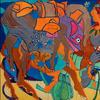Norman Rockwell Museum Nearly Doubles Collection With Gifts
- STOCKBRIDGE, Massachusetts
- /
- February 20, 2014
A transformational outcome of a collections development initiative launched five years ago, Norman Rockwell Museum has acquired the art and archives from the Famous Artists School in Westport, Connecticut, nearly doubling the museum’s collections. This major gift comprises more than 5,000 un-catalogued artworks, including several original works created by Norman Rockwell, plus an archive of hundreds of thousands of items.
With this newest acquisition, a collection that began with 125 paintings Norman Rockwell placed in trust with the Museum in 1974 now numbers more than 13,000 artworks. The Famous Artists School gift establishes Rockwell in the milieu of twentieth-century American illustration and advances the Museum’s aim to develop an encyclopedic collection of American illustration, creating a cultural context around its signature Norman Rockwell collection.
The Famous Artists School was founded in 1948 and became America’s most popular art correspondence course during the mid-twentieth century.
“Illustration art is a defining force in framing our history, shaping its narrative, and telling America’s story,” notes Museum Director/CEO Laurie Norton Moffatt. “We are the nation’s leading museum devoted entirely to the preservation and presentation of American illustration and to its intellectual and cultural engagement.”
Moffatt also notes that this newest gift helps the Museum “firmly place Rockwell within the arc of twentieth-century American illustration history, with its roots in nineteenth-century European and American narrative painting. By preserving and collecting works representing a broader visual narrative of America, we are doing something unique and vitally important for the nation—ensuring that the influential visual culture of our country’s history, experienced by millions through published mass media, is preserved for generations and secures its rightful place in the canon of American art history. It is urgent to save our nation’s visual history before it deteriorates and disappears.”
There are 17,500 art museums in the United States, however, only a handful are committed to collecting, exhibiting, and interpreting the art of illustration, including the Brandywine River Museum, Delaware Art Museum, the Library of Congress, Museum of American Illustration at the Society of Illustrators, National Museum of American Illustration, New Britain Museum of American Art, and the recently announced Lucas Cultural Arts Museum.
Beyond a dedicated group of collectors who passionately love illustration art, many illustrators’ life’s work is imperiled, languishing in attics, basements, and artists’ estates.
The Museum has made a concerted effort to build its collection through gifts, and over the past decade, it has grown tenfold. In addition to the Famous Artist School acquisition, the collection now includes nearly 800 artworks by Norman Rockwell and more than 7,100 artworks by other accomplished historical and contemporary illustrators—including the largest public collection of original drawings and cartoons by celebrated illustrator and children’s book author, William Steig (1907-2003), donated by his widow, Jeanne Steig.
Speaking on behalf of the Museum’s board of trustees, Board Chairman Anne H. Morgan said, “We extend our heartfelt thanks to the generous artists and collectors who have become the patrons of our remarkable collection, built entirely through their donations of American illustration. We are proud to be sharing these works locally, through traveling exhibitions, and online with an international audience eager to absorb the work of Rockwell and many other illustrators who portrayed American culture.”
Now in its 20th year, the Museum’s traveling exhibitions program has brought the nation’s most important illustrators to venues and audiences across the continent, inspiring appreciation for this highly visible but understudied American art form.
“The images of mass publication have shaped and reflected society’s aspirations and attitudes through the decades,” notes the Museum’s Deputy Director and Chief Curator, Stephanie Plunkett. “It has been exciting to encourage and witness a growing enthusiasm for the art of illustration, and challenging to satisfy the many requests for loans of original art from our collections by museums throughout the nation and the world. As keepers of ‘the people’s art,’ we strive to share our collections with the world across multiple platforms.”
Original Norman Rockwell Artwork Also Gifted
Values of Norman Rockwell art have soared into the millions of dollars (as witnessed in the most recent American art auctions of December 2013), eliminating the Museum’s ability to add to its collection by purchase. Therefore, the Museum is very pleased to announce several new donations of original Rockwell artwork to its collection.
Norman Rockwell’s 1947 painting “First Signs of Spring” was donated by Ginny Severinghaus of Nashville, Tennessee, in honor of her late husband Nelson ‘Ben’ Severinghaus. Originally created for the March 22, 1947 cover of “The Saturday Evening Post,” the humorous seasonal illustration features Rockwell’s Arlington, Vermont photographer/assistant Gene Pelham, and had previously been on long-term loan to the Museum.
An exceptional early example of his art, “The Cobbler Studying Doll’s Shoe,” Rockwell’s poignant 1921 “Literary Digest Cover,” was gifted by former Rockwell models, friends, and Museum trustees Jack and Jane Fitzpatrick of Stockbridge, Massachusetts.
“Fishing Trip, They’ll Be Coming Back Next Week” and “The Catch,” two 1919 paintings created by Rockwell for “Country Gentleman” magazine, were donated by the Rodger P. Nordblom Family of Boston, Massachusetts.
Museum Board President Robert Horvath, noted that “American illustrators painted a wide range of subjects, from reflections on society and cultural trends; visual commentary on urban, suburban, and rural life; icons of American visual culture; and images that reflect a sense of national identity. They pictured significant historical events and individuals, drawing inspiration from the larger world of art. Romantic depictions of adventure and chivalry, illustrated posters, narrative imagery for the young, decorative illustrations, humorous drawings, images for popular fiction and commercial product endorsements defined our understanding of America through visual imagery. A singular figure, Norman Rockwell is a master among them all.”

100x100_n.jpg)
100x100_c.jpg)










100x100_c.jpg)

